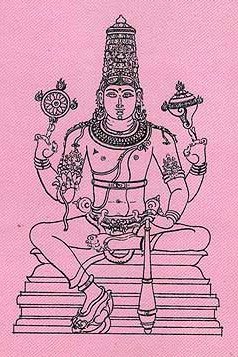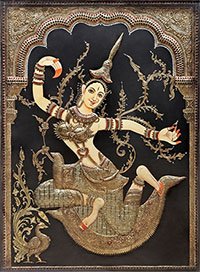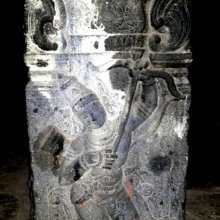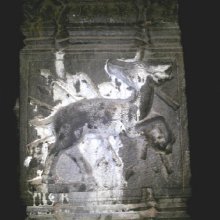Marica, Marīca, Mārīca, Mārica: 38 definitions
Introduction:
Marica means something in Buddhism, Pali, Hinduism, Sanskrit, Jainism, Prakrit, Marathi. If you want to know the exact meaning, history, etymology or English translation of this term then check out the descriptions on this page. Add your comment or reference to a book if you want to contribute to this summary article.
Alternative spellings of this word include Maricha.
Images (photo gallery)
In Hinduism
Ayurveda (science of life)
Cikitsa (natural therapy and treatment for medical conditions)
Source: Wisdom Library: Ayurveda: CikitsaMarica (मरिच):—A Sanskrit word referring to the “black pepper”, a flowering vine from the Piperaceae (pepper) family of flowering plants. It is used throughout Ayurvedic literature such as the Caraka-saṃhitā. Its official botanical name is Piper nigrum. It is native to south India and preferably grows in tropical regions.
This plant (Marica) is also mentioned as a medicine used for the treatment of all major fevers (jvara), as described in the Jvaracikitsā (or “the treatment of fever”) which forms the first chapter of the Sanskrit work called Mādhavacikitsā. In this work, the plant is also known by the names Ūṣaṇa or Śvetamārica. In this work, the plant is mentioned being part of the Trikaṭu group of medicinal drugs.
Source: Ancient Science of Life: Botanical identification of plants described in Mādhava CikitsāMarīca (मरीच) or Tryuṣaṇa (one of the tryuṣaṇa) refers to the medicinal plant Piper nigrum L., and is used in the treatment of atisāra (diarrhoea), according to the 7th century Mādhavacikitsā chapter 2. Atisāra refers to a condition where there are three or more loose or liquid stools (bowel movements) per day or more stool than normal. The second chapter of the Mādhavacikitsā explains several preparations [including Marīca] through 60 Sanskrit verses about treating this problem.
Dietetics and Culinary Art (such as household cooking)
Source: Shodhganga: Dietetics and culinary art in ancient and medieval IndiaMarica (मरिच) refers to a type of spices according to Gautama-Dharmasūtra XVII.32-33, and is commonly found in literature dealing with the topics of dietetics and culinary art, also known as Pākaśāstra or Pākakalā.—Spices referred to in Vedic literature are haridrā and pippalī. Dharmasūtra literature mentions other spices such as marica and hiṅgu.
Kalpa (Formulas, Drug prescriptions and other Medicinal preparations)
Source: Shodhganga: Edition translation and critical study of yogasarasamgrahaMarica (मरिच) refers to the medicinal plant known as “Piper nigrum Linn.” and is dealt with in the 15th-century Yogasārasaṅgraha (Yogasara-saṅgraha) by Vāsudeva: an unpublished Keralite work representing an Ayurvedic compendium of medicinal recipes. The Yogasārasaṃgraha [mentioning marica] deals with entire recipes in the route of administration, and thus deals with the knowledge of pharmacy (bhaiṣajya-kalpanā) which is a branch of pharmacology (dravyaguṇa).
Nighantu (Synonyms and Characteristics of Drugs and technical terms)
Source: WorldCat: Rāj nighaṇṭuMarica (मरिच) is the Sanskrit name for a medicinal plant identified with Piper nigrum Linn. or “black pepper” from the Piperaceae or “pepper” family of flowering plants, according to verse 6.30-32 of the 13th-century Raj Nighantu or Rājanighaṇṭu..—Marica is commonly known in Hindi as Kālīmirca; in Bengali as Golamaricha; in Gujarati as Mari or Kalamari; in Telugu as Miriyalatige; and in Tamil as Milagu; and in Kannada as Karemanesu.
Marica is mentioned as having sixteen synonyms: Palita, Śyāma, Kola, Vallīja, Uṣaṇa, Yavaneṣṭa, Vṛttaphala, Śākāṅga, Dharmapattana, Kaṭuka, Śirovṛtta, Vīra, Kaphavirodhi, Rūkṣa, Sarvahita and Kṛṣṇa.
Properties and characteristics: “Marica is pungent, bitter, hot and light. It quells vāta and kapha (i.e., kaphavāta-jit). It is indicated in worms and heart diseases and relieves anorexia (acting as appetiser)”.
Toxicology (Study and Treatment of poison)
Source: Shodhganga: Kasyapa Samhita—Text on Visha ChikitsaMarica (मरिच) refers to “white pepper” and is included in a (snake) poison antidote recipe, according to the Kāśyapa Saṃhitā: an ancient Sanskrit text from the Pāñcarātra tradition dealing with both Tantra and Viṣacikitsā—an important topic from Āyurveda which deals with the study of Toxicology (Viṣavidyā or Sarpavidyā).—Kāśyapa prescribes various antidotes to quell the poison by administering them through nasal drugs, collyrium, ointment, herbal drinks and diet. According to Kāśyapasaṃhitā (verse VIII.10)—“A combination of Śirīṣa juice, Indra Vāruṇi referred also as Sahasrakṛt, and white pepper (marica) serves as a thunderbolt to poison and can be used as either a collyrium or ointment or drink”.
Note: Pepper (marica) which belongs to both Vatsādi and Pippalyādi gaṇas cures cold, abdominal tumour and haemorrhoids, anaemia etc.
Unclassified Ayurveda definitions
Source: Google Books: Essentials of AyurvedaMarica (मरिच).—The Sanskrit name for an important Ayurvedic drug.—It is black in colour, pungent in taste, irritant, hot and pramāthī (eliminating malas from srotas as by churning). It breaks the mass of kapha and is anti-lipid.
Source: Ancient Science of Life: Vaidyavallabha: An Authoritative Work on Ayurveda TherapeuticsMarīca (मरीच) refers to Piper nigrum, and is recommended for use in headache, according to the 17th-century Vaidyavallabha (chapter 7) written by Hastiruci.—The Vaidyavallabha is a work which deals with the treatment and useful for all 8 branches of Ayurveda. The text Vaidyavallabha has been designed based on the need of the period of the author, availability of drugs (viz., marīca) during that time, disease manifesting in that era, socio-economical-cultural-familial-spiritual-aspects of that period Vaidyavallabha.
Marīca (Piper nigrum) is also recommended to cure diseases caused due to poison and its complications according to chapter 8.

Āyurveda (आयुर्वेद, ayurveda) is a branch of Indian science dealing with medicine, herbalism, taxology, anatomy, surgery, alchemy and related topics. Traditional practice of Āyurveda in ancient India dates back to at least the first millenium BC. Literature is commonly written in Sanskrit using various poetic metres.
Purana and Itihasa (epic history)
Source: archive.org: Puranic Encyclopedia1) Marīca (मरीच).—A Dānava. There is a reference to him in Uttara Rāmāyaṇa.
2) Mārīca (मारीच).—The uncle of Rāvaṇa.
2) . Birth. On the banks of the river Sarayū, there were two states lying adjacent called Malada and Karūṣa. The great sages conducted Jaladhārā (showering of water) on the head of Indra to absolve him of his sin of killing Vṛtrāsura at this place. At that time Mala (excreta) and Karūṣa (spittings) of Indra fell at those places and so they got the name of Malada and Karūṣa. At that place was born after a few years a demoness named Tāṭakā who had the strength of a thousand elephants. A demon called Sunda married Tāṭakā and she got two sons named Mārīca and Subāhu. (Sarga 24, Bāla Kāṇḍa, Vālmīki Rāmāyaṇa and Bāla Kāṇḍa, Kamba Rāmāyaṇa).
3) Mārīca (मारीच).—Kaśyapaprajāpati. Marīci was the father of Kaśyapa and so Kaśyapa was known as Mārīca also. (Sarga 46, Vālmīki Rāmāyaṇa).
Source: archive.org: Nilamata Purana: a cultural and literary studyMarica (मरिच) refers to Pepper nigrum, forming part of a common diet in ancient Kashmir (Kaśmīra) as mentioned in the Nīlamatapurāṇa.—Marica is mentioned as a spice to be taken with a preparation of barley (verse 722). Suśruta takes it along with vaca etc. as a good appetizer and absorbent of intestinal mucous and unassimilated lymphchyle. Most of the references to the articles of diet occur in the Nīlamata in connection with the offerings made to the gods but it is not difficult to infer from them the food and drink of the common people because “what a man eats his gods eat”.
Source: archive.org: Shiva Purana - English TranslationMarīca (मरीच) refers to “pepper”, which forms a preferable constituent for a great offering, according to the Śivapurāṇa 1.16. Accordingly, “[...] the great offering of eatables shall be made to Śiva especially in the month of Dhanus. The constituent parts of the great offering are as follows:—[...] pepper (marīca) measuring a prastha [...] This great offering of eatables made to the deities shall be distributed among devotees m the order of their castes”.
Source: Cologne Digital Sanskrit Dictionaries: The Purana Index1a) Mārīca (मारीच).—A son of Sunda and Tāḍaka; set up by Rāvaṇa to take the form of a golden deer in order to secure Sītā: killed by Rāma.*
- * Bhāgavata-purāṇa IX. 10. 5, 10; Brahmāṇḍa-purāṇa III. 5. 35-6; Vāyu-purāṇa 62. 72; Viṣṇu-purāṇa IV. 4. 89.
1b) The author of a Purāṇa: married Pulomā and Kālakā, daughters of Vaiśvānara: These had 1000 sons besides the fourteen who lived in Hiraṇyapura.*
- * Brahmāṇḍa-purāṇa II. 38. 5; III. 6. 26; 7. 464; 47. 60.
1c) (Mārīcakaśyapa): a son of Antardhāna and grandson of Pṛthu;1 his wife Vasu abandoned him for Soma;2 his sons are said to reside in the Somapatha worlds of the Pitṛs.3
1d) A devagaṇa.*
- * Brahmāṇḍa-purāṇa III. 1. 50.
1e) Kaśyapa gotrakāras.*
- * Matsya-purāṇa 199. 9.
Mārīca (मारीच), the son of demoness Tāṭikā. When Viśvāmitra asked Rāma to kill that impish woman and her two sons, the second son Mārīca, escaped from Rāma’s arrows and fled to the forests, engaged himself in ascetic activities. Rāvaṇa meets him and instigates him to take revenge on Rāma for killing his mother and brother.
Source: JatLand: List of Mahabharata people and placesMārīca (मारीच) is a name mentioned in the Mahābhārata (cf. I.70.9) and represents one of the many proper names used for people and places. Note: The Mahābhārata (mentioning Mārīca) is a Sanskrit epic poem consisting of 100,000 ślokas (metrical verses) and is over 2000 years old.
Source: Shodhganga: Elements of Art and Architecture in the Trtiyakhanda of the VisnudharmottarapuranaMārīca (मारीच) or Mārīcapurāṇa refers to one of the eighteen Minor Puranas (i.e., Upapurāṇa) according to the Kūrmapurāṇa and other traditional lists of Puranic literature: a category of ancient Sanskrit texts which gives a huge contribution in the development of Indian literature.—The Upapurāṇas (e.g., mārīca-purāṇa) can be considered as the supplements of the Mahāpurāṇas as those are mostly based on the Mahāpurāṇas. The Saurapurāṇa considers the Upapurāṇas as khilas i.e., supplements. [...] Though the numbers of Upapurāṇas are specified as eighteen, there are many important Upapurāṇas which are excluded from the lists of Upapurāṇas given by different sources.

The Purana (पुराण, purāṇas) refers to Sanskrit literature preserving ancient India’s vast cultural history, including historical legends, religious ceremonies, various arts and sciences. The eighteen mahapuranas total over 400,000 shlokas (metrical couplets) and date to at least several centuries BCE.
Pancaratra (worship of Nārāyaṇa)
Source: Shodhganga: Iconographical representations of Śiva (pancaratra)Mārīca (मारीच) or Mārīcasaṃhitā is the name of a Vaiṣṇava Āgama scripture, classified as a rājasa type of the Muniprokta group of Pāñcarātra Āgamas. The vaiṣṇavāgamas represent one of the three classes of āgamas (traditionally communicated wisdom).—Texts of the Pāñcara Āgamas are divided in to two sects. It is believed that Lord Vāsudeva revealed the first group of texts which are called Divya and the next group is called Muniprokta which are further divided in to three viz. a. Sāttvika. b. Rājasa (e.g., Mārīca-saṃhitā). c. Tāmasa.

Pancaratra (पाञ्चरात्र, pāñcarātra) represents a tradition of Hinduism where Narayana is revered and worshipped. Closeley related to Vaishnavism, the Pancaratra literature includes various Agamas and tantras incorporating many Vaishnava philosophies.
Kavya (poetry)
Source: archive.org: Naisadhacarita of SriharsaMarica (मरिच) refers to “black pepper”, and is mentioned in the Naiṣadha-carita 18.118.—(“maricāvacūrṇanā”).

Kavya (काव्य, kavya) refers to Sanskrit poetry, a popular ancient Indian tradition of literature. There have been many Sanskrit poets over the ages, hailing from ancient India and beyond. This topic includes mahakavya, or ‘epic poetry’ and natya, or ‘dramatic poetry’.
Shaktism (Shakta philosophy)
Source: Google Books: ManthanabhairavatantramMārīca (मारीच) refers to one of the eight Servants (ceṭa-aṣṭaka) associated with Pūrṇagiri or Pūrṇapīṭha (which is located in the northern quarter), according to the Manthānabhairavatantra, a vast sprawling work that belongs to a corpus of Tantric texts concerned with the worship of the goddess Kubjikā.—[...] The eight servants: Pulinda, Śavara, Unmatta, Palāśana, Ulūka, Mārīca, Sumatta, Bhayaṃkara.

Shakta (शाक्त, śākta) or Shaktism (śāktism) represents a tradition of Hinduism where the Goddess (Devi) is revered and worshipped. Shakta literature includes a range of scriptures, including various Agamas and Tantras, although its roots may be traced back to the Vedas.
Sports, Arts and Entertainment (wordly enjoyments)
Source: archive.org: Syainika Sastra of Rudradeva with English Translation (art)Mārica (मारिच) refers to “(powdered) pepper” (used in the treatment of Hawks), according to the Śyainika-śāstra: a Sanskrit treatise dealing with the divisions and benefits of Hunting and Hawking, written by Rājā Rudradeva (or Candradeva) in possibly the 13th century.—Accordingly, [while discussing the treatment of hawks]: “[...] If the disease is the effect of the morbid condition of the phlegm, powdered pepper (mārica) [māricaṃ cūrṇaṃ] is to be first administered as a snuff, and then meat mixed with the powdered bark of Morunga quilandina, is to be given. The drink should be warm water; musk may also be given to cure its symptoms. [...]”.

This section covers the skills and profiencies of the Kalas (“performing arts”) and Shastras (“sciences”) involving ancient Indian traditions of sports, games, arts, entertainment, love-making and other means of wordly enjoyments. Traditionally these topics were dealt with in Sanskrit treatises explaing the philosophy and the justification of enjoying the pleasures of the senses.
General definition (in Hinduism)
Source: Apam Napat: Indian MythologyMaricha was originally a Yaksha, the son of Tataka and Sunda. When his father was killed by a curse of the sage Agastya, he tried to attack the sage along with his mother. Both of them were cursed to become demons by that sage. He is a kinsman of the Asura king Ravana.
Along with his brother Subahu, he used to disrupt the Vedic rituals conducted by sage Vishwamitra by throwing unclean meat and blood into the oblation fire. Vishwamitra then sought the help of the Kosala princes Rama and Laxmana to guard his sacrifice. When the two Asuras attempted to disrupt the sacrifice, Rama slew Subahu with a divine missile, Maricha escaped, by running away to Lanka.
Source: WikiPedia: HinduismMārīca (मारीच): A character in the Ramayana, uncle of Ravana who transformed himself into a golden deer at the behest of Ravana to entice Sita.
In Buddhism
Tibetan Buddhism (Vajrayana or tantric Buddhism)
Source: Wisdom Library: Tibetan Buddhism1) Marīca (मरीच) is the name of a Mahoraga mentioned as attending the teachings in the 6th century Mañjuśrīmūlakalpa: one of the largest Kriyā Tantras devoted to Mañjuśrī (the Bodhisattva of wisdom) representing an encyclopedia of knowledge primarily concerned with ritualistic elements in Buddhism. The teachings in this text originate from Mañjuśrī and were taught to and by Buddha Śākyamuni in the presence of a large audience (including Marīca).
2) Mārīca (मारीच) is another name of a Mahoraga also mentioned as attending the teachings in the 6th century Mañjuśrīmūlakalpa.

Tibetan Buddhism includes schools such as Nyingma, Kadampa, Kagyu and Gelug. Their primary canon of literature is divided in two broad categories: The Kangyur, which consists of Buddha’s words, and the Tengyur, which includes commentaries from various sources. Esotericism and tantra techniques (vajrayāna) are collected indepently.
General definition (in Buddhism)
Source: Wisdom Library: BuddhismMarīca (मरीच)—One of the field-crops mentioned in the Jātakas.
In Jainism
General definition (in Jainism)
Source: archive.org: TrisastisalakapurusacaritraMārīca (मारीच) is the name of a warrior fighting on Rāvaṇa’s side, according to the Jain Ramayana and chapter 7.7 [The killing of Rāvaṇa] of Hemacandra’s 11th century Triṣaṣṭiśalākāpuruṣacaritra: an ancient Sanskrit epic poem narrating the history and legends of sixty-three illustrious persons in Jainism.—Accordingly, “[...] When Kākutstha was nearby, like Saturn in Pisces, Laṅkā trembled in every direction, fearing the end of the world. Rāvaṇa’s vassals armed themselves for battle, Hasta, Prahasta, Mārīca, Sāraṇa, and others by the thousand. Rāvaṇa, expert in beating enemies, had the cruel battle-drums beaten by the crore by servants. [...]”.

Jainism is an Indian religion of Dharma whose doctrine revolves around harmlessness (ahimsa) towards every living being. The two major branches (Digambara and Svetambara) of Jainism stimulate self-control (or, shramana, ‘self-reliance’) and spiritual development through a path of peace for the soul to progess to the ultimate goal.
Languages of India and abroad
Pali-English dictionary
Source: BuddhaSasana: Concise Pali-English Dictionarymarica : (nt.) pepper; chillies.
Source: Sutta: The Pali Text Society's Pali-English DictionaryMarica, (nt.) (cp. scientific Sk. marica) black pepper Vin. I, 201 (allowed as medicine to the bhikkhus); Miln. 63.

Pali is the language of the Tipiṭaka, which is the sacred canon of Theravāda Buddhism and contains much of the Buddha’s speech. Closeley related to Sanskrit, both languages are used interchangeably between religions.
Marathi-English dictionary
Source: DDSA: The Molesworth Marathi and English Dictionarymarīca (मरीच).—n S Black pepper.
Marathi is an Indo-European language having over 70 million native speakers people in (predominantly) Maharashtra India. Marathi, like many other Indo-Aryan languages, evolved from early forms of Prakrit, which itself is a subset of Sanskrit, one of the most ancient languages of the world.
Sanskrit dictionary
Source: DDSA: The practical Sanskrit-English dictionaryMarica (मरिच) or Marīca (मरीच).—The pepper-shrub.
-cam Black pepper; खर्बूरं मरिचं पूगं देवदारु च नागरम् (kharbūraṃ maricaṃ pūgaṃ devadāru ca nāgaram) Śiva B.3.16; N.18.118.
Derivable forms: maricaḥ (मरिचः), marīcaḥ (मरीचः).
--- OR ---
Mārica (मारिच).—a. (-cī f.) Made of pepper.
--- OR ---
Mārīca (मारीच).—a. (-cī f.) Belonging to or composed by Marīchi.
-caḥ 1 Name of a demon, son of Sunda and Tāḍakā. He assumed the form of a golden deer, and thus enticed Rāma to a considerable distance from Sītā, so that Rāvaṇa found a good opportunity to carry her off.
2) A large or royal elephant.
3) A kind of plant (Mar. kaṃkoḷa).
4) Name of the sage Kaśyapa; cf. स्वायंभुवान्मरीचेर्यः प्रबभूव प्रजापतिः (svāyaṃbhuvānmarīceryaḥ prababhūva prajāpatiḥ) Ś.7.9.
5) A sacrificing priest.
-cī 1 Name of the mother of Śākyamuni.
2) Name of a Buddhist goddess.
3) Name of an Apsaras.
-cam A collection of pepper shrubs.
Source: Cologne Digital Sanskrit Dictionaries: Edgerton Buddhist Hybrid Sanskrit DictionaryMārīca (मारीच).—name of a serpent king: (Ārya-)Mañjuśrīmūlakalpa 18.24.
Source: Cologne Digital Sanskrit Dictionaries: Shabda-Sagara Sanskrit-English DictionaryMarica (मरिच).—n.
(-caṃ) Pepper. E. mṛ to die, (venom,) and ic aff.; considered as an antidote; also marīca .
--- OR ---
Marīca (मरीच).—n.
(-caṃ) Pepper, (Piper nigrum.) E. mṛ to die, īca aff.
--- OR ---
Mārīca (मारीच).—m.
(-caḥ) 1. The name of a Rakshasa, the son of Sunda and Tadaka. He allured Rama away in the form of a golden deer and thus assisted Ravana in his design of carrying off Sita. 2. A military or royal elephant. 3. A sort of berry, commonly Kakkoli. f. (-cī) A goddess, peculiar to the Baudd'has. n.
(-caṃ) A collection of pepper plants. E. marīca a saint, &c. aff. aṇ .
Source: Cologne Digital Sanskrit Dictionaries: Benfey Sanskrit-English DictionaryMarica (मरिच).—marīca, n. Pepper.
Marica can also be spelled as Marīca (मरीच).
--- OR ---
Mārīca (मारीच).—i. e. marīci + a, m. The name of a Muni, [Śākuntala, (ed. Böhtlingk.)] 100, 8; of a Rākṣasa, [Rāmāyaṇa] 3, 48, 2.
Source: Cologne Digital Sanskrit Dictionaries: Cappeller Sanskrit-English DictionaryMarica (मरिच).—[masculine] the pepper shrub; [neuter] grain of pepper.
--- OR ---
Marīca (मरीच).—[masculine] & [neuter] = [preceding]; [masculine] also = marīci [masculine]
--- OR ---
Mārīca (मारीच).—[adjective] relating to Marīci; [masculine] = seq.
Source: Cologne Digital Sanskrit Dictionaries: Monier-Williams Sanskrit-English Dictionary1) Marica (मरिच):—m. the pepper shrub, [Rāmāyaṇa; Varāha-mihira; Suśruta]
2) a kind of Ocimum, [cf. Lexicographers, esp. such as amarasiṃha, halāyudha, hemacandra, etc.]
3) Strychnos Potatorum, [cf. Lexicographers, esp. such as amarasiṃha, halāyudha, hemacandra, etc.] ([varia lectio] marīca)
4) Name of a man, [Rājataraṅgiṇī]
5) n. black pepper, [Suśruta]
6) a [particular] fragrant substance (= kakkolaka), [cf. Lexicographers, esp. such as amarasiṃha, halāyudha, hemacandra, etc.]
7) Marīca (मरीच):—[from marica] m. the pepper shrub (also -kṣupa), [Harivaṃśa]
8) [v.s. ...] Strychnos Potatorum, [cf. Lexicographers, esp. such as amarasiṃha, halāyudha, hemacandra, etc.] ([varia lectio] marica)
9) [v.s. ...] marjoram, [cf. Lexicographers, esp. such as amarasiṃha, halāyudha, hemacandra, etc.]
10) [v.s. ...] Name of the father of Kaśyapa, [Catalogue(s)]
11) [v.s. ...] of a son of Sunda, [Viṣṇu-purāṇa]
12) [v.s. ...] n. black pepper, [cf. Lexicographers, esp. such as amarasiṃha, halāyudha, hemacandra, etc.]
13) Mārica (मारिच):—mfn. ([from] marica) made of pepper, peppery
14) n. (with cūrṇa) ground or pounded pepper, [Harivaṃśa]
15) Mārīca (मारीच):—mfn. belonging or relating to or composed by Marīci, Madhus
16) m. ([patronymic] [from] marīci) Name of Kaśyapa, [Mahābhārata; Rāmāyaṇa] etc.
17) a royal elephant, [cf. Lexicographers, esp. such as amarasiṃha, halāyudha, hemacandra, etc.]
18) a species of plant (= kakkola), [cf. Lexicographers, esp. such as amarasiṃha, halāyudha, hemacandra, etc.]
19) Name of a Rākṣasa, [Mahābhārata; Harivaṃśa; Rāmāyaṇa]
20) n. ([from] marīca) a grove of pepper plants, [Raghuvaṃśa]
21) Name of [commentator or commentary] on [Siddhāntaśiromaṇi]
Source: Cologne Digital Sanskrit Dictionaries: Yates Sanskrit-English Dictionary1) Marica (मरिच):—(caṃ) 1. n. Pepper.
2) Marīca (मरीच):—(caṃ) 1. n. Pepper.
3) Mārīca (मारीच):—(caḥ) 1. m. The name of a Rākshasa; royal elephant; a berry. f. (cī) A Jaina goddess.
Source: DDSA: Paia-sadda-mahannavo; a comprehensive Prakrit Hindi dictionary (S)Mārīca (मारीच) in the Sanskrit language is related to the Prakrit words: Mārijja, Māria.
[Sanskrit to German]
Sanskrit, also spelled संस्कृतम् (saṃskṛtam), is an ancient language of India commonly seen as the grandmother of the Indo-European language family (even English!). Closely allied with Prakrit and Pali, Sanskrit is more exhaustive in both grammar and terms and has the most extensive collection of literature in the world, greatly surpassing its sister-languages Greek and Latin.
Kannada-English dictionary
Source: Alar: Kannada-English corpusMarica (ಮರಿಚ):—
1) [noun] the vine Piper nigrum of Piperaceae family.
2) [noun] its small, pungent seed, dried and used as a condiment; pepper.
--- OR ---
Marīca (ಮರೀಚ):—[noun] = ಮರಿಚ [marica].
--- OR ---
Mārīca (ಮಾರೀಚ):—[noun] of, relating to or composed by the sage Marīca.
--- OR ---
Mārīca (ಮಾರೀಚ):—
1) [noun] (myth.) Kaśyapa, a sage son of Marīca.
2) [noun] name of a demon in Rāmāyaṇa, the great Indian epic.
3) [noun] a field where pepper is cultivated.
4) [noun] a priest who conducts religious sacrifices.
5) [noun] the plant Luvunga eleutherandra of Rutaceae famiy.
Kannada is a Dravidian language (as opposed to the Indo-European language family) mainly spoken in the southwestern region of India.
See also (Relevant definitions)
Starts with (+2): Maricacunna, Maricacurna, Maricadi, Maricaditala, Maricagaccha, Maricagiri, Maricaka, Maricakashyapa, Maricakshupa, Marical, Maricalavanadi, Maricam, Marican, Maricapattraka, Maricapurana, Maricasamhita, Maricate, Maricatirtha, Maricavamsha, Maricavatti.
Ends with: Sahamarica, Seto-marica, Shvetamarica, Sitamarica, Sthulamarica, Sugandhamarica, Tambara marica, Tiktamarica.
Full-text (+100): Maricam, Shvetamarica, Sthulamarica, Sitamarica, Sahamarica, Tadaka, Marici, Tiktamarica, Ushana, Maricakshupa, Maricika, Arpamaricam, Maricapattraka, Vesha, Shadushana, Tambara marica, Mayamriga, Kharbura, Upapurana, Maricya.
Relevant text
Search found 56 books and stories containing Marica, Marīca, Mārīca, Mārica; (plurals include: Maricas, Marīcas, Mārīcas, Māricas). You can also click to the full overview containing English textual excerpts. Below are direct links for the most relevant articles:
Garga Samhita (English) (by Danavir Goswami)
Verse 8.13.29 < [Chapter 13 - A Thousand Names of Lord Balarāma]
Rig Veda (translation and commentary) (by H. H. Wilson)
The Agni Purana (by N. Gangadharan)
Chapter 7 - Manifestation of Viṣṇu as Rāma (part 3)
Chapter 5 - Manifestation of Viṣṇu as Rāma
Chapter 141 - Description of herbs used in charms, medicines etc.
Historical Elements in the Matsya Purana (by Chaitali Kadia)
Name of the Purāṇas < [Chapter 1 - An Introduction of the Purāṇas]
Lineages of Kaśyapa < [Chapter 6 - Human history in the Matsya-Purāṇa]
Ramayana of Valmiki (by Hari Prasad Shastri)
Chapter 42 - Other Monkeys are sent to explore the Western Region < [Book 4 - Kishkindha-kanda]
Chapter 44 - Rama slays Marica < [Book 3 - Aranya-kanda]
Chapter 42 - Marica assuming the form of a Deer goes to the Hermitage < [Book 3 - Aranya-kanda]
Bhesajjakkhandhaka (Chapter on Medicine) (by Hin-tak Sik)
Medicines (e): Fruits (Phala) < [Chapter 4 - Medicinal Substances in the Chapter on Medicine]
Related products
(+32 more products available)







